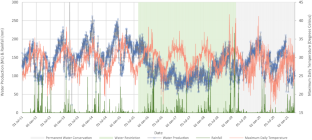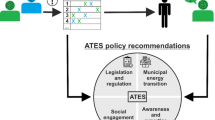Abstract
Regional cities are having their unique water security challenges due to regional urban water contexts, regional socio-economic structure, and climate conditions. Regional urban community’s perceptions of water usage are expected to be different from the communities in large metropolitan cities. The city of Townsville is the largest regional city in the northern tropical region of the state of Queensland in Australia, and it is known to have its unique dry tropic climate condition. The city faced a water crisis due to a prolonged drought in 2013–2018. As part of this research, at first, a literature review was conducted to understand what water demand management (WDM) tools worked well during urban water crisis in different parts of the world. This paper then investigates how residential water usage changed with the changes in drought measures in the city of Townsville in the last decade. A minimum per capita residential water requirement is established for the study region to benchmark the effects of tools implemented in the region. The paper investigates the WDM policies implemented in the city of Townsville including when the policies were applied and the impacts and efficacy of these policies before water crisis, during water crisis and after water crisis. The most effective WDM tools identified are water restrictions, public awareness raising and education programmes. The impacts of water restriction policies and the perceptions of local water professionals on their success elements are also studied. The results are compared and the reasons behind the findings are investigated.


Similar content being viewed by others
Data availability
All data generated or analysed during this study are included in this article. Water consumption data, water production and climate data used in this research can be accessed from the public websites of Townsville City Council (TCC) and Bureau of Meteorology (BoM), Australia.
References
Alamanos A, Sfyris S, Fafoutis C, Mylopoulos N (2020) Urban water demand assessment for sustainable water resources management, under climate change and socioeconomic changes. Water Sci Technol Water Supply 20(2):679–687. https://doi.org/10.2166/ws.2019.199
Albannay S, Kazama S, Oguma K, Hashimoto T, Takizawa S (2021) Water demand management based on water consumption data analysis in the Emirate of Abu Dhabi. Water (Basel) 13(20):2827. https://doi.org/10.3390/w13202827
Arbués F, Villanúa I (2006) Potential for Pricing Policies in Water Resource Management: Estimation of Urban Residential Water Demand in Zaragoza, Spain. Urban Stud 43(13):2421–2442. http://www.jstor.org/stable/43201420
Australian Bureau of Statistics (ABS) (2021) Population Projections Australia. https://www.abs.gov.au/statistics/people/population/population-projections-australia
Beal CD, Stewart RA (2011) South-East Queensland Residential End Use Study: Final Report. Urban Water Security Research Alliance Technical Report No. 47
Beer A, Clower T (2009) Specialisation and Growth: Evidence from Australia’s Regional Cities. Urban Stud 46(2):369–389
Bischoff-Mattson Z, Maree G, Vogel C, Lynch A, Olivier D, Terblanche D (2020) Shape of a water crisis: practitioner perspectives on urban water scarcity and “Day Zero” in South Africa. Water Policy 22(2):193–210. https://doi.org/10.2166/wp.2020.233
Biswas R, Sharma R, Gyasi-Agyei Y (2022) Urban water crises: making sense of climate change adaptation barriers and success parameters. Clim Serv 27:100302. https://doi.org/10.1016/j.cliser.2022.100302
Biswas R, Sharma R, Gyasi-Agyei Y, Rahman A (2023) Urban water security: water supply and demand management strategies in the face of climate change. Urban Water J 20(6):723–737. https://doi.org/10.1080/1573062X.2023.2209549
Bolorinos J, Ajami NK, Rajagopal R (2020) Consumption change detection for urban planning: monitoring and segmenting water customers during drought. Water Resour Res 56(3):e2019WR025812. https://doi.org/10.1029/2019WR025812
Braga B, Kelman J (2016) Facing the challenge of extreme climate: the case of Metropolitan São Paulo. Water Policy 18(S2):52–69. https://doi.org/10.2166/wp.2016.113
Browne OR, Gazze L, Greenstone M (2021) Do conservation policies work? evidence from residential water use. Environ Energy Policy Econ 2(1):190–225. https://doi.org/10.1086/711310
Bureau of Meteorology (BoM) (2022a) Climate data online. http://www.bom.gov.au/climate/data/
Bureau of Meteorology (BoM) (2022b) Climate change – trends and extremes. http://www.bom.gov.au/climate/change/
Caball R, Malekpour S (2019) Decision making under crisis: lessons from the Millennium Drought in Australia. Int J Disaster Risk Reduct 34:387–396
Cairns Regional Council (CRC) (2023) Water Strategy and Policy. https://www.cairns.qld.gov.au/water-waste-roads/water/strategy
Campbell HE, Johnson RM, Larson EH (2004) Prices, devices, people, or rules: the relative effectiveness of policy instruments in water conservation. Rev Policy Res 21(5):637–662. https://doi.org/10.1111/j.1541-1338.2004.00099.x
Castledine A, Moeltner K, Price M, Stoddard SW (2014) Free to choose: promoting conservation by relaxing outdoor watering restrictions. J Econ Behav Organ 107. https://doi.org/10.1016/j.jebo.2014.02.004
Connellan G (2013) Water use efficiency for irrigated turf and landscape. CSIRO PUBLISHING. https://www.perlego.com/book/1468519/water-use-efficiency-for-irrigated-turf-and-landscape-pdf
Cooper B, Burton M, Crase L (2019) Willingness to pay to avoid water restrictions in Australia under a changing climate. Environ Resour Econ 72(3):823–847. https://doi.org/10.1007/s10640-018-0228-x
Corbella HM, Sauri D (2009) What lies behind domestic water use? A review essay on the drivers of domestic water consumption. Bol Asoc Geógr Esp 50(50):297–314
Domene E, Saurí D (2006) Urbanisation and water consumption: Influencing factors in the metropolitan region of Barcelona. Urban Stud 43(9):1605–1623
Dronyk-Trosper T, Stitzel B (2020) Analyzing the effect of mandatory water restrictions on water usage. B E J Econ Anal Policy 20(2):1–13. https://doi.org/10.1515/bejeap-2019-0137
DSITI (2015) Model for Effluent Disposal using Land Irrigation. Department of Science, Information Technology and Innovation (DSITI), Queensland Government
Fielding KS, Russell S, Spinks A, Mankad A (2012) Determinants of household water conservation: the role of demographic, infrastructure, behavior, and psychosocial variables. Water Resour Res 48:W10510. https://doi.org/10.1029/2012WR012398
Furlong C, Gan K, De Silva S (2016) Governance of integrated urban water management in Melbourne, Australia. Uti Policy 43:48–58. https://doi.org/10.1016/j.jup.2016.04.008
Hanak E, Lund J (2012) Adapting California’s water management to climate change. Clim Change 111(1):17–44
Inman D, Jeffrey P (2006) A review of residential water conservation tool performance and influences on implementation effectiveness. Urban Water J 3(3):127–143. https://doi.org/10.1080/15730620600961288
IPOS (2009) Code of practice for irrigated public open space. SA Water, Government of South Australia
Koop S, Van Leeuwen K (2017) The challenges of water, waste and climate change in cities. Environ Dev Sustain 19. https://doi.org/10.1007/s10668-016-9760-4
Low KG, Grant SB, Hamilton AJ, Gan K, Saphores JD, Arora M, Feldman DL (2015) Fighting drought with innovation: Melbourne’s response to the Millennium Drought in Southeast Australia. WIREs Water 2(4):315–328. https://doi.org/10.1002/wat2.2015.2.issue-410.1002/wat2.1087
Mackay Regional Council (MRC). (2016). Mackay Water Strategy. Available at https://www.mackay.qld.gov.au/__data/assets/pdf_file/0013/230116/CPPMackay_Water_Strategy_002.pdf
Maggioni E (2015) Water demand management in times of drought: what matters for water conservation. Water Resour Res 51(1):125–139. https://doi.org/10.1002/2014WR016301
March H, Saurí D (2010) The suburbanization of water scarcity in the Barcelona Metropolitan Region: sociodemographic and urban changes influencing domestic water consumption. Prof Geogr 62(1):32–45
Matikinca P, Ziervogel G, Enqvist JP (2020) Drought response impacts on household water use practices in Cape Town, South Africa. Water Policy 22(3):483–500. https://doi.org/10.2166/wp.2020.169
Meyer et al. (1985) Irrigation of turfgrass below replacement of evapotranspiration as a means of water conservation: determining crop coefficient of turfgrasses. In: Lemaire F (ed) Proc. 5th Intl. Turfgrass Research Conf., Avignon, France, July 1985. INRA Publications, Versailles, France, p 357–364
Millington N, Scheba S (2021) Day zero and the infrastructures of climate change: water governance, inequality, and infrastructural politics in Cape Town’s water crisis. Int J Urban Reg Res 45(1):116–132
Muller M (2020) Some systems perspectives on demand management during cape town’s 2015-2018 water crisis Int J Water Resour Dev 36(6):1054–1072. https://doi.org/10.1080/07900627.2019.1667754
Olmstead S, Stavins R (2009) Comparing price and non-price approaches to urban water conservation. Water Resour Res. 45. https://doi.org/10.1029/2008WR007227
Parker JM, Wilby RL (2013) Quantifying household water demand: a review of theory and practice in the UK. Water Resour Manag 27:981–1011. https://doi.org/10.1007/s11269-012-0190-2
Phipps M, Brace-Govan J (2011) From right to responsibility: sustainable change in water consumption. J Public Policy Mark 30(2):203–219
Pincetl S, Porse E, Mika KB, Litvak E, Manago KF, Hogue TS, Gillespie T, Pataki DE, Gold M (2019) Adapting urban water systems to manage scarcity in the 21st century: the case of Los Angeles. Environ Manag 63(3):293–308. https://doi.org/10.1007/s00267-018-1118-2
Queensland Government (QG) (2022) Queensland future climate dashboard. https://longpaddock.qld.gov.au/qld-future-climate/dashboard/
Rathnayaka K, Malano HM, Maheepala S, George B, Nawarathna B, Arora M, Roberts P (2015) Seasonal demand dynamics of residential water end-uses. Water 7:202–216
Sousa COM, Teixeira LV, Fouto NMMD (2022) Midterm impacts of a water drought experience: evaluation of consumption changes in São Paulo, Brazil. Water Policy 24(1):179–191. https://doi.org/10.2166/wp.2021.120
Sousa Jr W, Baldwin C, Camkin J, Fidelman P, Silva O, Neto S, Smith TF (2016) Water: drought, crisis and governance in Australia and Brazil. Water (Basel) 8(11):493
Standards Australia (SA) (2012) AS/NZS1547: 2012 On-site domestic wastewater management. https://www.standards.org.au/standards-catalogue/sa-snz/waterandwasteservices/ws-013/as-slash-nzs--1547-2012
Stauffer C (2016) Drought ends Brazil’s Sao Paolo but future still uncertain. Reuters. https://www.reuters.com/article/us-brazil-water/drought-ends-in-brazils-sao-paulo-but-future-still-uncertain-idUSKCN0VRlYJ
Stavenhagen M, Buurman J, Tortajada C (2018) Saving water in cities: assessing policies for residential water demand management in four cities in Europe. Cities 79. https://doi.org/10.1016/j.cities.2018.03.008
Taing L, Chang CC, Pan S, Armitage NP (2019) Towards a water secure future: reflections on cape town’s day zero crisis. Urban Water J 16(7):530–536. https://doi.org/10.1080/1573062X.2019.1669190
Tortajada C, González-Gómez F, Biswas A, Buurman J (2019) Water demand management strategies for water-scarce cities: the case of Spain. Sustain Cities Soc 45:649–656. https://doi.org/10.1016/j.scs.2018.11.044
Townsville City Council (TCC) (2019) Water package launches jobs, smart water use across. https://www.townsville.qld.gov.au/about-council/news-and-publications/media-releases/2019/july/water-package-launches-jobs,-smart-water-use-across-city
Townsville City Council (TCC) (2022) Role and strategy. https://www.townsville.qld.gov.au/water-waste-and-environment/water-supply-and-dams/role-and-strategy
Visser W (2018) A perfect storm: the ramifications of Cape Town’s drought crisis. TD – J Transdiscipl Res S Afr 14(1):El–El0
Wichman CJ, Taylor LO, von Haefen R (2014) Conservation policies: who responds to price and who responds to prescription? Comparative Political Economy: Regulation eJournal
Willis RM, Stewart RA, Panuwatwanich K, Williams PR, Hollingsworth AL (2011) Quantifying the influence of environmental and water conservation attitudes on household end use water consumption. J Environ Manag 92(8):1996–2009. https://doi.org/10.1016/j.jenvman.2011.03.023
Xu K, Bin L, Xu X(2019) Assessment of water resources sustainability in mainland China in terms of water intensity and efficiency. Environ Manag 63:309–321. https://doi.org/10.1007/s00267-018-1098-2
Yin RK (2009) Case Study Research: Design and Methods, 4 ed. SAGE, Los Angeles
Zapana-Churata L, March H, Sauri D (2022) Water demand management strategies in fast-growing cities. The case of Arequipa, Perú. Int J Water Resour Dev 38(3):363–387. https://doi.org/10.1080/07900627.2021.1903401
Acknowledgements
The authors would like to thank the local City Council for supporting this research work by providing valuable information and feedback. It needs to be noted that the local water distribution authority does not take any responsibility on the reliability/accuracy of the information used for this research. The authors are grateful to the water professionals who participated in this research that yielded valuable information.
Funding
This research work was supported by the Australian Government Research Training Program Scholarship provided by the Department of Education, Skills and Employment, Government of Australia.
Author information
Authors and Affiliations
Contributions
RRB: assist in data collection, writing—review and editing and supervision. TRB: conceptualisation, methodology, data access and formal analysis, investigation, writing—original draft and writing—review and editing. AR: writing—review and editing and supervision.
Corresponding author
Ethics declarations
Conflict of interest
The authors declare no competing interests.
Additional information
Publisher’s note Springer Nature remains neutral with regard to jurisdictional claims in published maps and institutional affiliations.
Rights and permissions
Springer Nature or its licensor (e.g. a society or other partner) holds exclusive rights to this article under a publishing agreement with the author(s) or other rightsholder(s); author self-archiving of the accepted manuscript version of this article is solely governed by the terms of such publishing agreement and applicable law.
About this article
Cite this article
Ray Biswas, R., Ray Biswas, T. & Rahman, A. Benchmarking the Effects of Water Demand Management During Water Crisis in a Regional City. Environmental Management 72, 1277–1292 (2023). https://doi.org/10.1007/s00267-023-01862-5
Received:
Accepted:
Published:
Issue Date:
DOI: https://doi.org/10.1007/s00267-023-01862-5




